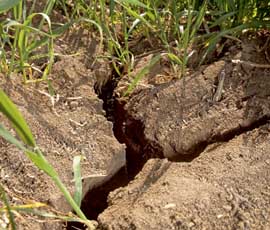Drought status looms for Midlands and South West

The Midlands and south-west England could be the next regions to be declared officially in drought, the Environment Agency has said.
Yorkshire was the latest county to receive a drought status last week, but now the government agency is warning that the drought is spreading west.
East Anglia and south-east England are already in drought. Parts of the Midlands and the South West are also experiencing the impacts of the dry weather.
In Wales, the current position and outlook for the summer is normal. However, an exceptionally dry spring and summer could change the position in Wales, the agency has warned.
Trevor Bishop, Environment Agency water resources head, told BBC Radio 4’s Today programme that the drought situation was worsening and looked likely to spread west.
“If we see a continuation of dry weather, which is now very likely, these conditions will probably extend further westward over the next couple of months,” said Mr Bishop.
“Our rivers are really important, but also the water is needed for our businesses, people, the economy and for farmers. It’s all very reliant on the winter rainfalls, to replenish the natural resources.
“For two years in a row, that simply hasn’t happened at sufficient levels.”
Water companies were investing in reservoirs, desalination plants and ways to transport water around the country, he added.
The latest drought management report from the Environment Agency, released on Friday (30 March) said that river flows were continuing to decrease and were similar to flows at the same time in March 1976.
The number of agricultural licences where farmers cannot abstract due to low flow conditions on their licences has increased with 116 licences affected in east Anglia and 143 in the Midlands. In the South East, the number of restrictions remains unchanged at 205.
Hosepipe bans are due to start in East Anglia and parts of south-east England on Thursday (5 April).
Met Office figures from 1 March to 28 March showed that most areas received less than half the average amount of rainfall.
For this period, the whole of the UK had just 36mm of rainfall – 38% of the annual average rainfall. The driest areas included: east and north-east England with 21.7mm (35%), south-west England with 30.9mm (31%) and Northern Ireland with 21.4mm (23%).
However, Scotland and Wales have also been dry, with 55.7mm and 32mm falling respectively, or 40% and 25% of the annual average rainfall.
A Met Office spokesman said: “March has been dry and sunny with less than 50% of the historical average rainfall recorded for most regions.”
